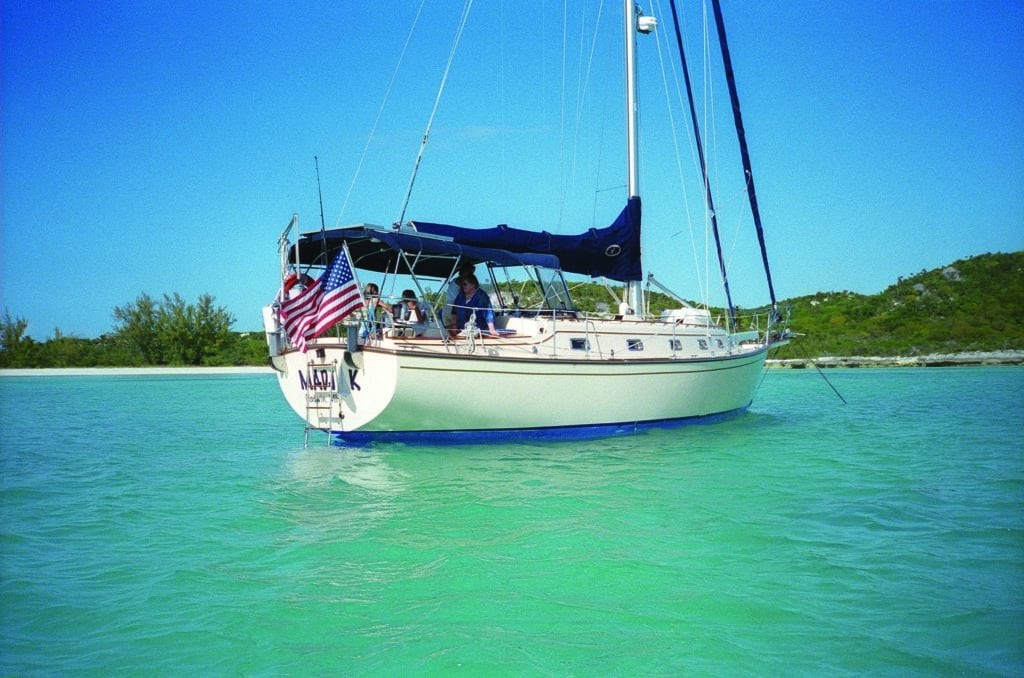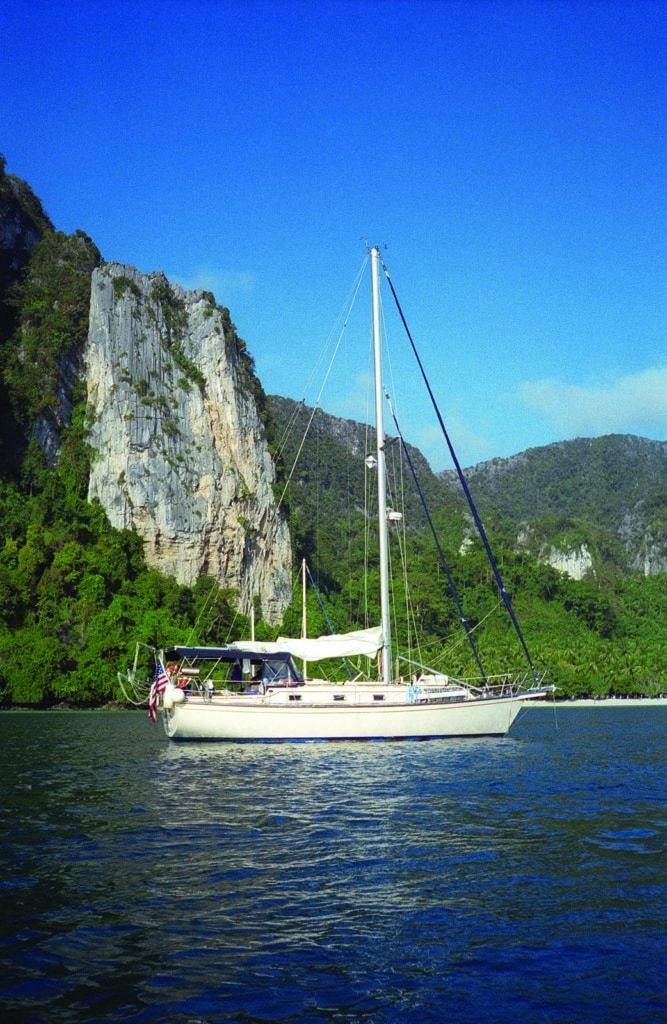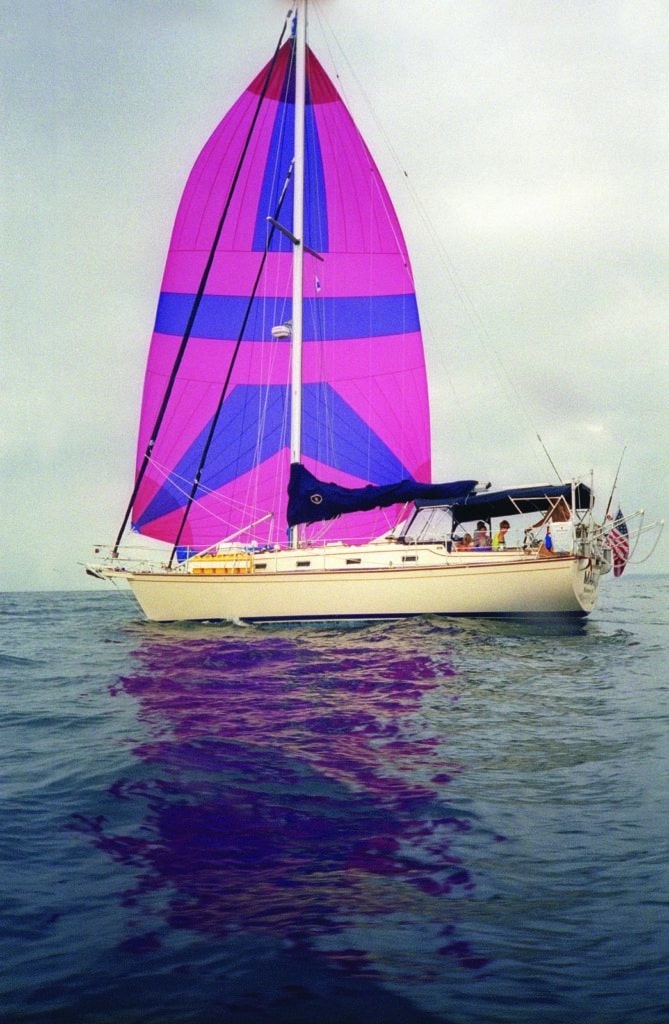
Bob Johnson started Island Packet Yachts in 1979 with a 26-foot cruising cutter. Over time, the company introduced incrementally bigger boats with similar “traditional American” styling and in the builder’s trademark ivory color. The Island Packet 40 came out in 1994, and 139 were built by the time the model was replaced in 2000.
In 1997, with our three children old enough to swim but not yet teenagers, it was time for my wife, Amy, and me to buy the “big boat” to fulfill our dream of sailing around the world. We needed a “bulletproof” boat that was safe, seakindly, able to handle big seas and survive a grounding, and also have great resale value. My research steered me straight to the Island Packet 40. With its Full Foil Keel, which contains 10,000 pounds of internal ballast and protects the rudder and propeller, it fit the bill. Strong stanchions and lifelines, handholds in the right spots on deck and a huge protected bowsprit for anchoring added to the appeal.

Sailing offshore in wind and swells, the IP 40 really shone, and we averaged 150-mile days on trade-wind passages. We appreciated the seakindly motion during an El Niño year with 35-knot winds the norm in the Pacific.
The full-battened main with two reefing points was the workhorse, and the most-used headsail was the 130- percent genoa on roller furling. In light winds, we found adding the staysail to the full main and genoa was not effective, so we would normally fly the gennaker. We used the staysail mainly in heavy weather.
Except for the gennaker, all the sails can easily be handled entirely from the cockpit.
We spent most of our waking hours in the IP 40’s 8-foot cockpit. The helmsman’s seat is raised, with back support, and affords a good view; the Edson steering gives good feedback to the helmsman. A shallow storage bin is under the port-side seating, and the starboard cockpit seat lifts to reveal a huge locker below. The table folds down and is compact enough to keep the cockpit open. Below, the saloon feels like that of a much larger boat due to the clever table that folds up and locks onto the forward bulkhead. Forward, the master cabin has a queen berth and its own head. The chain locker in the peak is accessible through this head. Aft is a cabin with little headroom over the berth but ample standing headroom next to the bunk. A second head is accessible from the saloon and from the aft cabin.
The U-shaped galley is the best I have ever seen on a monohull under 45 feet. Amy loved the craftsmanship in the woodwork and the teak cabin sole, and thought the easily cleaned fiberglass sole in the galley and heads was ingenious.
The IP’s overall quality of construction is outstanding, but we had trouble with a few things. Water would get into the propane locker and cause the solenoid to fail, and the gennaker halyard chafed through where it exited the mast (we replaced it with an external halyard).
The standard sail plan has the staysail set on a Hoyt jib boom. If I were to do it again, I would do without the boom and clean up the foredeck. Another simple improvement would be a larger winch for raising the mainsail. This may have been addressed on later boats.
We sold our IP 40 after our 29,765-nautical-mile circumnavigation for slightly more than we paid for her new. Asking prices today range from $160,000 to $225,000.
Mike Smith, his wife, Amy, and their children, Dani, Jaye and Kegan, made a trade-wind circumnavigation via the Red Sea in the years 1997 to 2000.
This article first appeared in Cruising World March, 2014.

Island Packet 40 Specs:
LOA: 41′ 6″ (12.68 m.)
LOD: 39′ 4″ (11.99 m.)
LWL: 34′ 0″ (10.36 m.)
Beam: 12′ 11″ (3.94 m.)
Draft: 4′ 8″ (1.42 m.)
Sail Area: (100%) 775 sq. ft. (72.0 sq. m.)
Disp.: 22,280 lb. ( kg.)
Ballast: 10,000 lb. ( kg.)
Ballast/Disp.: .44
Disp./L: 253
SA/Disp.: 15.7
Water: 170 gal. (644 l.)
Fuel: 170 gal. (644 l.)
Engine: Yanmar 54 hp
Designer: Robert K. Johnson








